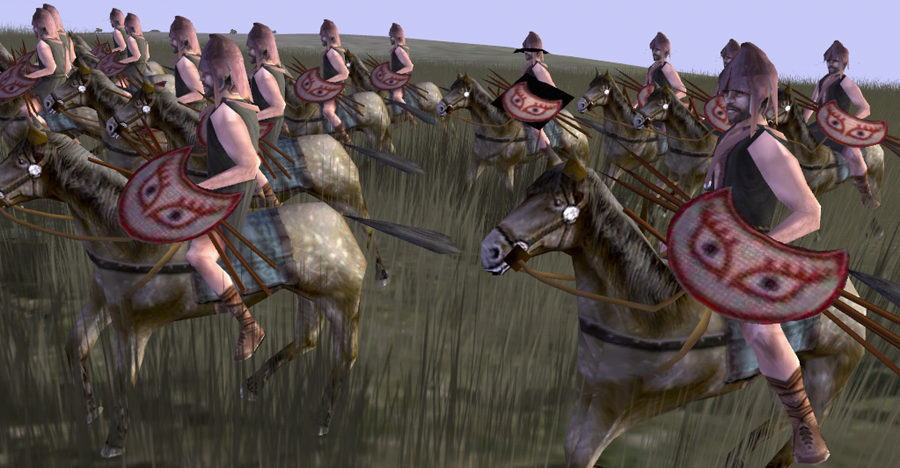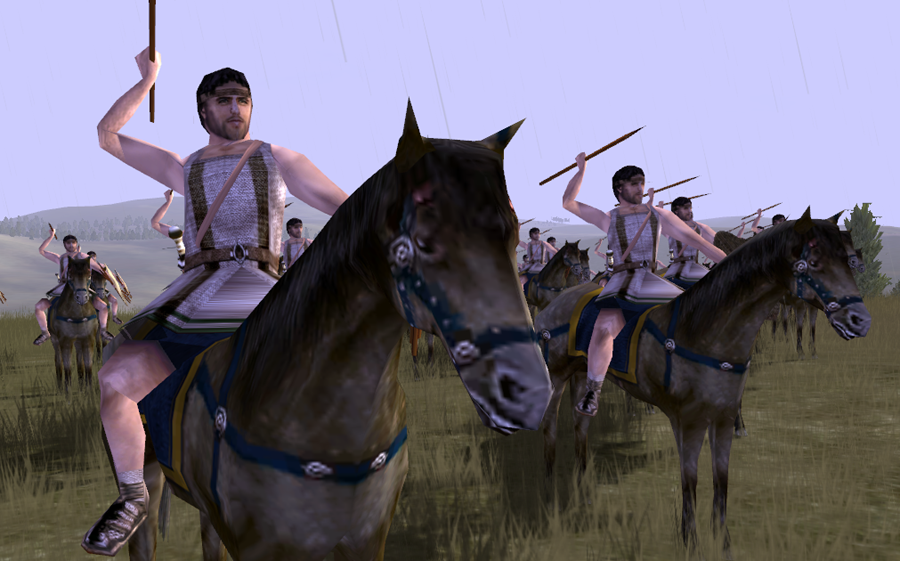
Various references from across the web
Greece: Not cavalry-friendly
 It seems like an evidence, but Greece is a throwout of rugged, mountainous landscape into the sea, with little room to spare for cavalry, with one exception though: The northern, central lands of Thessalia. There, a cavalry tradition developed as horse breeding fed the many city states own gentry. Even aristocratic foot hoplite during the VIth-Vth centuries were named "Hippeis" because outside war, these wealthy citizens possessed a horse for their personal displacements. This was a different affair in nearby Thrace and Epirus, which at least had a cavalry tradition, and more so in northern Macedon, which large, fertile landscapes were linked by horses, and the elite formed various cavalry corps, started with the Somatophylakes, or bodyguards and in particular the Basilike Ilè. But these were developed in the times of Philip II and more so with his son Alexander III, a proficient user of cavalry since his young age. Due south, in mainland Greece, war has long been an almost exclusively hoplitic affair, very regimented and ceremonial, almost like a sport, with relatively few deads, only in the summer and in a few flat locations between rival City-states.
It seems like an evidence, but Greece is a throwout of rugged, mountainous landscape into the sea, with little room to spare for cavalry, with one exception though: The northern, central lands of Thessalia. There, a cavalry tradition developed as horse breeding fed the many city states own gentry. Even aristocratic foot hoplite during the VIth-Vth centuries were named "Hippeis" because outside war, these wealthy citizens possessed a horse for their personal displacements. This was a different affair in nearby Thrace and Epirus, which at least had a cavalry tradition, and more so in northern Macedon, which large, fertile landscapes were linked by horses, and the elite formed various cavalry corps, started with the Somatophylakes, or bodyguards and in particular the Basilike Ilè. But these were developed in the times of Philip II and more so with his son Alexander III, a proficient user of cavalry since his young age. Due south, in mainland Greece, war has long been an almost exclusively hoplitic affair, very regimented and ceremonial, almost like a sport, with relatively few deads, only in the summer and in a few flat locations between rival City-states.
Nevertheless, it was common to use cavalry for reconnaissance, usually a single, skilled, lightly equipped horseman, perhaps even unarmed, which was able to spot the enemy marching or camp, and came back for report. But this was probably with the Peloponnesian war that the use of cavalry was scaled up as the goals and grand strategy of this giant chess party between on one side Athens and its allies, and Sparta, competed for Hegemon (Domination) along the Mediterranean. Unlike previous small scale conflicts, the Peloponnesian war (431-404 BC) saw many revolutions in warfare, and the inclusion, outside the bulk of any army still made of hoplites of all social conditions, addition of peasants used s auxiliary spearmen to guard the baggage train, or skirmishers (Peltastai and Akontistai), archers (Toxotai) and slingers (Sphendonetai). The second were usually first hunters, the last ones shepherds, well used to their weapon. They were generally called the "psiloi" or "throwers". Soon, professional cavalrymen from Thessalia were paid as mercenaries to perform a medium cavalry duty, posted on the wings and able to combat the possible enemy cavalry and/or surround and rear-attack the hoplitic phalanx of the enemy's wings. A lancer's cavalry most probably, it was quite different than the Southern Italy mercenary cavalry called "Tarentine", using an aspis and javelins instead. On the lowest level of any cavalry, the lightest mounted combatants were the Hippakontistai, driven from the peasantry, wealthy enough to possess a horse.

The Hippakontistai: Tactics and equipment
The name itself was a simple construction "hippos akontistai", meaning acontos-bearer on horse, or "Hippos Akontistes" ("cavalry javelineer"). These were simply light mounted javelineers. They needed to be so in order to perform their reconnaissance duties. Being light meaning being able to cross any terrain, running fast to skirmish properly, cover more terrain and carry out more complex and fast flanking maneuvers as well as screening the army for possible ambushes and flank attacks. Both a vanguard and advance party, in force, they coud also deal with enemy cavalry or similar role, or medium cavalry, at least enough to delay it long enough for better units to catch up the melee. These light cavalrymen were also ideal for quick raids by night and day, made provocations in order to drag some enemy units into a chase, like foot Psiloi, but more efficiently. They were also perfect to cut off, chase and destroy these foot psiloi vanguards, much slower, and also drag the enemy cavalry out of the wings, leaving them unprotected for other units to take care of. Light Cavalry was also used at the end of the battle, to finish off routed infantry, a practice which became commonplace in the more merciless Peloponnesian war battles. They mounted also small horse, nervous and indigenous to Europe at that time (now extinct), comparable to the Mongol steppe horse. Aristocrats usually mounted much larger eastern cavalry, imported.
Fresco of the tomb of Niausta, late fourth century BC BC, representing a rider charging a Persian soldier.
The Hippakontistai in sources
Probably the most compelling description of a light cavalry of this style, although not strictly speaking Hellenistic, was Polybius own depiction of the Numidian cavalry at work, that Livy called "by far the best horsemen in Africa.". Polybius did not hesitated to compare them to Centaurs, such was their skills and agility, "like a flock of birds", able to change direction in an instant. They fought a bit like water, striking when spotting a weak point, and retiring immediately to avoid any casualty and continue this harassing for hours on end. They charged in loose formations and lobbed their javelins to the enemy before wheeling off to escape any counterattack. far from being a decisive tactic it was very effective to frustrate and tire the enemy. The Scythians, Sarmatians, Parthians and others of the many steppe peoples of the east basically used the same tactics but with far more deadly recurved, composite bows. A largely foot army was particularly a good target for such tactics, as to inflict gradual damage while staying out of reach. It was easy to see, when discipline broke out, small groups of men chasing them, then be quickly surrounded, cut off and killed. William the Conqueror used such tactics with his Norman cavalry against the Saxons in 1066. After having failed to break the Saxon shieldwall, he just thrown his cavalrymen in javelin attacks, punctuated with arrows showers, until King Harold was famously killed by an arrow in the eye and both discipline and cohesion began to fall down.
catw's own depiction of Hellenistic Hippakontistai, young mounted javelineers
Feigning retreat, he gradually drawn men from the shieldwall into the open, easy to kill, and creating gaps in the line, easier to exploit when at some point the whole Norman infantry climbed in turn the hill. However to be true, no "hippakontistai" was named as such in any Hellenistic description so far. It's rather a recent "invention" to name a type that has existed in many variants. In fact all mounted javelinmen fell under this category. In the Alexandrian era, the prodromoi (scouts), were also called sarisophoroi (or sarissa bearers), and were relatively light, not wearing any body armour. There was one particular painting to show that (see above). It is clear for some description that some of these prodromoi did not carry a sarissa but javelins instead. However Prodromoi disappear from sources after 330 BC. They have been probably divided into official hippakontistai and sarisophoroi hippeis two types of light riders that existed possibly welcoming young Macedonians before their integration into the heavy cavalry as shown by the ephemeral law of Amphipolis, riding and equestrian exercises being part of the education of young Macedonians. They later would join Companions to form the new hipparchias created by Alexander.
Other sources
Ueda-Sarson, Luke, The Evolution of Hellenistic Infantry, Part 1: The Reforms of IphikratesMattew, C. (2015) An Invincible Beast: Understanding the Hellenistic Pike Phalanx in Action, Pen and Sword
♕ Aquitani & Vasci ♕ Celts ♕ Indo-greeks ♕ Veneti ♕ Yuezhi ♕ Indians ♕ Etruscans ♕ Numidians ♕ Samnites ♕ Judaean ♕ Ancient Chinese ♕ Corsico-Sardinians
⚔ Cingetos ⚔ Immortals ⚔ Cavaros ⚔ Cataphract ⚔ Romphaiorioi ⚔ Chalkaspidai ⚔ Devotio Warrior ⚔ Scythian Horse archer ⚔ The Ambactos ⚔ Iberian warfare ⚔ Illyrian warriors ⚔ Germanic spearmen ⚔ Carthaginian Hoplite ⚔ Thracian Peltast ⚔ Caetrati ⚔ Ensiferi ⚔ Hippakontistai ⚔ Hastati ⚔ Gaesatae ⚔ Cretan Archer ⚔ Thorakitai ⚔ Soldurii ⚔ Iphikrates ⚔ Kardaka ⚔ The thureophoroi